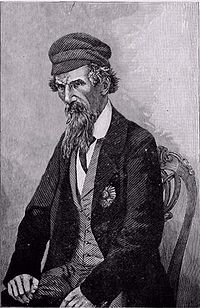Henry Lawrence's "Young Men"
This article needs additional citations for verification. (June 2014) |
Henry Lawrence's "Young Men", also known as "the Paladins of the Punjaub", were a group of
Collectively these men laid the foundations of British rule in the
Background
Following the successful defeat of the
The death of Ranjit Singh in 1839 marked a period of instability within the Sikh Empire.
The British marched unopposed into Lahore on 20 February 1846 and a peace treaty, known as the Treaty of Lahore was drawn up by Frederick Currie. A supplement to the treaty stipulated that a British force would remain in Lahore until no longer than the end of the year "for the purpose of protecting the person of the Maharajah and the inhabitants of the City of Lahore, during the reorganisation of the Sikh Army.[6] Towards the end of 1846, the Treaty of Bhyrowal was ratified, which provided that a Resident British officer, with an efficient establishment of assistants, was to be appointed by the Governor-General to remain at Lahore, with "full authority to direct and control all matters in every Department of the State".[7]
Paladins of the Punjaub
The new Resident was to be Henry Lawrence, who had assisted Currie in the drafting of the Lahore Treaty. Lawrence would subsequently hand pick a number of assistants to carry out his orders. These included contemporaries such as
Lawrence was always on the lookout for new recruits and carried around a notebook recording names and observations.[10] The charismatic Lawrence nurtured his proteges into a brotherhood of young men, sharing a vocation, very much a band of brothers, Paladins at the court of their mentor and master.[11]
The
"Young Men"

- James Abbott
- Lewin Bowring
- Neville Bowles Chamberlain
- John Coke
- Henry Coxe
- Henry Daly
- Herbert Edwardes
- William Hodson
- George Lawrence
- Harry "Joe" Lumsden
- Frederick Mackeson
- Philip Melvill
- John Nicholson
- Richard Pollock
- Reynell Taylor
- Patrick Alexander Vans Agnew
Further reading
- Political Diaries of the Agent to the Governor General, North West Frontier and Resident at Lahore from 1 January 1847 to 4 March 1848 (reprint ed.). Lahore: Sang-e-Meel Publications. 2005. ISBN 969-35-1766-0.
- Political Diaries of Lieut. H. B. Edwardes, Assistant to the Resident at Lahore 1847-1849 (reprint ed.). Lahore: Sang-e-Meel Publications. 2006. ISBN 969-35-1770-9.
- Political Diaries of Lieutenant Reynell G. Taylor, Mr. P. Sandys Melvill, Pandit Kunahya Lal, Mr. P. A. Vans Agnew, Lieutenant J. Nicholson, Mr. L. Bowring and Mr. A. H. Cocks, 1847-1849 (reprint ed.). Lahore: Sang-e-Meel Publications. 2006. ISBN 969-35-1771-7.
- Allen, Charles (2000). Soldier Sahibs: the men who made the North-West Frontier. London: John Murray. ISBN 978-0-349-11456-9.
References
- ^ Gazetteer of the Peshawar District 1897–98 (reprint ed.). Lahore: Sang-e-Meel Publications. 1989. p. 78.
- ^ Joe Bindloss, Northeast India, Lonely Planet, 2009, page 31
- ^ Edward Ingram. The International History Review, Vol. 2, No. 2 (Apr., 1980), pp. 160–171. Published by: Taylor & Francis, Ltd. Stable URL: https://www.jstor.org/stable/40105749 Great Britain's Great Game: An Introduction
- ISBN 0-7509-3162-0, page 546
- ISBN 1-84022-216-6, page 30
- ^ Article 1 to 4 of the supplementary Agreement
- ^ Article 2 of the Treaty of Bhyroval
- ^ Charles Allen, Soldier Sahibs: The Men Who Made the North-West Frontier, Hachette UK, 21 June 2012
- ^ Stephen Wade, Spies in the Empire: Victorian Military Intelligence, Anthem Press, 1 Jul 2007, p.36
- ^ Stephen Wade, Spies in the Empire: Victorian Military Intelligence, Anthem Press, 1 Jul 2007, p.36
- ^ Stephen Wade, Spies in the Empire: Victorian Military Intelligence, Anthem Press, 1 Jul 2007, p.7
- ^ Gazetteer of the Multan District 1923–24 (reprint ed.). Lahore: Sang-e-Meel Publications. 2001. p. 283.
